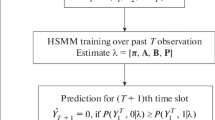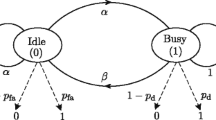Abstract
This paper explores the learning capability of hidden Markov model (HMM) in capturing the temporal correlation and predicting primary user (PU) activity pattern of real spectrum data of GSM-900 band through an USRP-LabVIEW platform for cognitive radio (CR) systems. The inability of the widely used stationary Markov model in estimating the occupancy pattern of primary channels for a long duration of time has been verified. We proposed an alternative duty cycle (DC)–based two-state discrete-time Markov chain (DTMC-DC) model. Analysis of empirical data indicates that DC required for a non-stationary DTMC-DC model can be well approximated by a trapezoidal shape and the PU spectrum usage pattern estimated using DTMC-DC is capable of learning the statistical behavior (length of idle and busy interval periods) of a real channel accurately with a reduced complexity.











Similar content being viewed by others
References
Monteiro JME (2012) Cognitive radio: survey on communication protocols, spectrum decision issues, and future research directions. Wirel Netw 18(2):147. https://doi.org/10.1007/s11276-011-0392-1
Wang B, Liu KJR (2011) Advances in cognitive radio networks: a survey. IEEE J Sel Top Signal Process 5(1):5. https://doi.org/10.1109/JSTSP.2010.2093210
Pandit G, Singh S (2017) An overview of spectrum sharing techniques in cognitive radio communication system. Wirel Netw 23(2):497. https://doi.org/10.1007/s11276-015-1171-1
Liang YC, Zeng Y, Peh EC, Hoang AT (2008) Sensing-throughput tradeoff for cognitive radio networks. IEEE Trans Wirel Commun 7(4):1326
Khalid L, Anpalagan A (2016) Adaptive assignment of heterogeneous users for group-based cooperative spectrum sensing. IEEE Trans Wirel Commun 15(1):232
Chen CY, Chou YH, Chao HC, Lo CH (2012) Secure centralized spectrum sensing for cognitive radio networks. Wirel Netw 18(6):667. https://doi.org/10.1007/s11276-012-0426-3
Thakur P, Kumar A, Pandit S, Singh SN, Satashia G (2017) Performance analysis of high-traffic cognitive radio communication system using hybrid spectrum access, prediction and monitoring techniques. Wirel Netw: 1–11. https://doi.org/10.1007/s11276-016-1440-7
Sung KW, Kim SL, Zander J (2010) Temporal spectrum sharing based on primary user activity prediction. IEEE Trans Wirel Commun 9(12):3848
He A, Bae KK, Newman TR, Gaeddert J, Kim K, Menon R, Morales-Tirado L, Zhao Y, Reed JH, Tranter WH et al (2010) A survey of artificial intelligence for cognitive radios. IEEE Trans Veh Technol 59(4):1578
Saad W, Han Z, Poor HV, Basar T, JuBin S (2012) A cooperative bayesian nonparametric framework for primary user activity monitoring in cognitive radio networks. IEEE J Sel Areas Commun 30(9):1815
Grimmer J (2011) An introduction to bayesian inference via variational approximations. Polit Anal 19(1):32
Schrodt PA (2006) In: Programming for peace. Springer, pp 161–184
Tumuluru VK, Wang P, Niyato D (2012) Channel status prediction for cognitive radio networks. Wireless Communications and Mobile Computing 12:862–874. https://doi.org/10.1002/wcm.1017
Ahmadi H, Chew YH, Tang PK, Nijsure YA (2011) In: 2011 IEEE 22nd International Symposium on Personal, Indoor and Mobile Radio Communications, pp 401–405
Cacciapuoti AS, Caleffi M, Marino F, Paura L (2016) On the impact of primary traffic correlation in tv white space. IEEE Access 4:7199
Melián-Gutiérrez L, Zazo S, Blanco-Murillo JL, Pérez-Álvarez I, García-rodríguez A, Pérez-díaz B (2013) Hf spectrum activity prediction model based on hmm for cognitive radio applications. Phys Commun 9:199
Chen Z, Guo N, Hu Z, Qiu RC (2011) Experimental validation of channel state prediction considering delays in practical cognitive radio. IEEE Trans Veh Technol 60(4):1314
Nguyen T, Mark BL, Ephraim Y (2013) Spectrum sensing using a hidden bivariate markov model. IEEE Trans Wirel Commun 12(9):4582
Akbar IA, Tranter WH (2007) In: SoutheastCon, 2007. Proceedings. IEEE. IEEE, pp 196–201
Zhao Q, Swami A (2007) A decision-theoretic framework for opportunistic spectrum access. IEEE Wireless Communications 14(4):14–20. https://doi.org/10.1109/MWC.2007.4300978
Rondeau TW, Rieser CJ, Gallagher TM, Bostian CW (2004) In: Microwave Symposium Digest, 2004 IEEE MTT-S International. IEEE, vol 2, pp 739–742
Ghosh C, Cordeiro C, Agrawal DP, Rao MB (2009) In: IEEE International Conference on Pervasive Computing and Communications. IEEE, pp 1–6
Carniani LVR, Giupponi A (2010) https://doi.org/10.1109/ew.2010.5483438
Abdou A, Najajri O, Jamoos A (2017) In: 2017 IEEE Jordan Conference on Applied Electrical Engineering and Computing Technologies (AEECT), pp 1–5. https://doi.org/10.1109/AEECT.2017.8257748
Luis RDRBL, Oliveira M (2017) Rf-spectrum opportunities for cognitive radio networks operating over gsm channels. IEEE Transactions on Cognitive Communications and Networking, pp 3. https://doi.org/10.1109/TCCN.2017.2771558
Xing X, Jing T, Huo Y, Li H, Cheng X (2013) In: INFOCOM, 2013 Proceedings IEEE. IEEE, pp 1465–1473
Chen X, Zhang H, MacKenzie AB, Matinmikko M (2014) Predicting spectrum occupancies using a non-stationary hidden markov model. IEEE Wirel Commun Lett 3(4):333
Bepari D, Kumar P, Choudhary SK (2018) In: 2018 9th International Conference on Computing, Communication and Networking Technologies (ICCCNT), pp 1–5. https://doi.org/10.1109/ICCCNT.2018.8493839
Macaluso I, Ahmadi H, DaSilva LA (2015) Fungible orthogonal channel sets for multi-user exploitation of spectrum. IEEE Trans Wirel Commun 14(4):2281
López-Benítez M, Casadevall F (2011) In: 2011 IEEE Symposium on New Frontiers in Dynamic Spectrum Access Networks (DySPAN). IEEE, pp 90–99
Lopez-Benitez M, Casadevall F (2011) Empirical time-dimension model of spectrum use based on a discrete-time markov chain with deterministic and stochastic duty cycle models. IEEE Trans Veh Technol 60(6):2519
Koley S, Mirza V, Islam S, Mitra D (2015) Gradient-based real-time spectrum sensing at low snr. IEEE Commun Lett 19(3): 391
Yin S, Chen D, Zhang Q, Liu M, Li S (2012) Mining spectrum usage data: a large-scale spectrum measurement study. IEEE Trans Mob Comput 11(6):1033
Tranter WH, Rappaport TS, Kosbar KL, Shanmugan KS (2004) Principles of communication systems simulation with wireless applications, vol 1. Prentice Hall, New Jersey
Candy JV (2009) Bayesian signal processing: classical, modern, and particle filtering methods, vol 1. Wiley-Interscience
Author information
Authors and Affiliations
Corresponding author
Additional information
Publisher’s note
Springer Nature remains neutral with regard to jurisdictional claims in published maps and institutional affiliations.
Rights and permissions
About this article
Cite this article
Bepari, D., Koley, S. & Mitra, D. Empirical validation and performance of duty cycle–based DTMC model in channel estimation. Ann. Telecommun. 75, 229–240 (2020). https://doi.org/10.1007/s12243-019-00747-1
Received:
Accepted:
Published:
Issue Date:
DOI: https://doi.org/10.1007/s12243-019-00747-1




